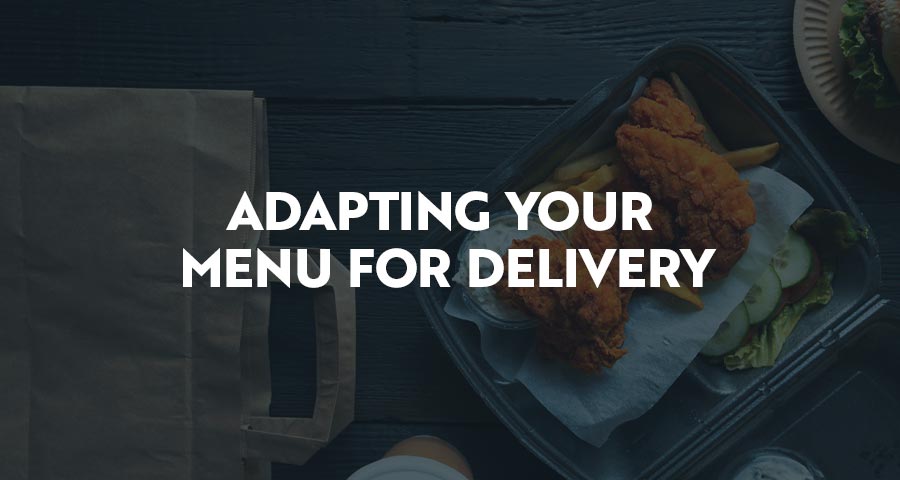Convenience is quickly becoming one of the most important selling points in the restaurant industry. More than ever, people expect to have their food arrive at their door so they can enjoy their meal from the comfort and safety of their own homes. Since 2017, food delivery has more than tripled to become a $150 billion industry.
While delivery offers another market for restaurants to take advantage of, it also presents several challenges. One of these challenges is figuring out how you can adapt your menu for delivery. It might seem like an easy transition at first glance, but there are a lot of details to keep in mind as you start offering delivery at your restaurant.
This article looks at all those details and helps you figure out how to make a delivery menu that suits your customers’ needs.
1. Make Sure You’re Ready
The first thing to do is make sure you’re prepared to offer a delivery option. If you jump right in and start the process, you may be halfway through before realizing you don’t have the resources available to offer delivery. It’s important to remain patient and organized and look at the costs involved in offering delivery. You’ll have to consider factors such as packaging and how you will deliver food to customers. If you’re thinking about using a third party for delivery, some of your delivery revenue will go to them.
Look at your budget and do a cost-benefit analysis to see if delivery will be right for your restaurant. Doing the research upfront before you even begin can set you up for success and give you confidence that offering a delivery option will benefit your business.
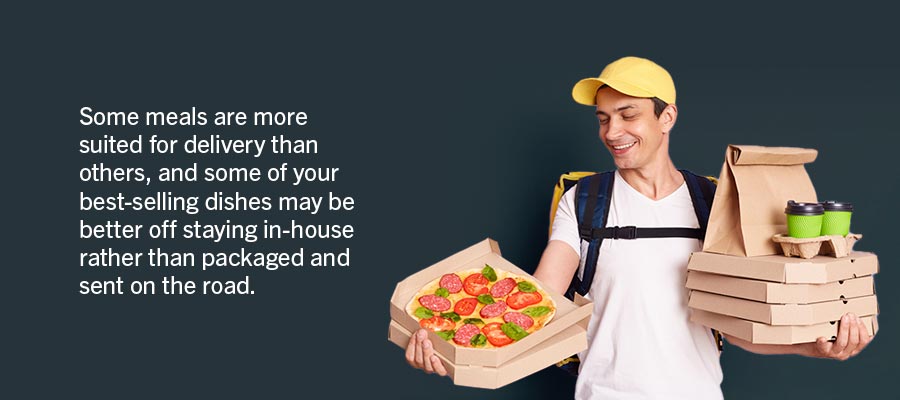
2. Adapt Your Menu Items for Delivery
When determining how you can make a delivery menu, keep in mind the food you’ll send to customers. Some meals are more suited for delivery than others, and some of your best-selling dishes may be better off staying in-house rather than packaged and sent on the road. Here are some foods that work well for delivery:
- Sandwiches
- Wraps
- Sushi rolls
- Pizza
- Tacos
Many finger-food favorites will be perfect for delivery since these foods keep well and still taste fresh when the customer receives them. On the other hand, some foods may not be as suitable for delivery, including:
- Fried foods
- Pasta
- Ice cream
- Steak
- Dishes requiring heavy sauce
Fried foods tend to get soggy the longer they sit. That ideal crispness may be entirely gone by the time these foods reach the customer. Pasta can become gluey and stick together, while ice cream will quickly melt on the road. As steak travels, it will continue to cook in the heat, making it more well-done than the customer probably ordered it. And dishes with heavy sauces can create spills during delivery.
It’s important to consider those small details as you craft your delivery menu — you may even want to create new dishes for delivery and see which ones perform well. When starting your delivery program, you’ll likely need to experiment to see what items travel well or what adjustments you need to make.
Some of your restaurant’s favorite dishes may not be suitable for delivery. You can tweak certain dishes to make them better suited for travel. Instead of sending the meal as a whole, for example, you could place certain ingredients in separate containers to preserve freshness. Bread bowls might become cups of soup, while fresh seafood might transition to a sushi option. For a noodle soup dish, you could package the noodles separately from the soup to prevent the noodles from overcooking. The more creative and open-minded you are, the better you can adapt your menu for delivery.
3. Use the Right Packaging
Obviously, you won’t offer the same elegant dishware and fine dining experience to your delivery customers. You need to find the right packaging so meals will stay fresh and presentable when they arrive. Here are some factors to keep in mind when it comes to choosing food delivery packaging:
- Size: Choose containers to fit the food they’ll hold. An oversized box for a small salad will be harder to transport and waste resources, while a pizza box that’s too small will mean slices stacked on each other. The right-sized containers will ensure that delivery goes smoothly and also makes meals more presentable.
- Organization: As mentioned earlier, many dishes can get soggy or gluey if they’re layered with sauce before delivery. It might be better to separate those sauces into individual containers. Packing ingredients and sauces separately will help keep meals fresh and allow customers to add the amount they want to their food.
- Insulation: Many restaurants use insulated food bags to keep meals fresh. One of the most important parts of offering a delivery service is ensuring meals are at the right temperature when they get to the customer. This might mean keeping a pasta dish hot or a dessert cold. Either way, you’ll want to use the insulated packaging to maintain a hot or cold temperature. Proper packaging will prevent hot dishes from getting soggy and help cold foods stay chilled.
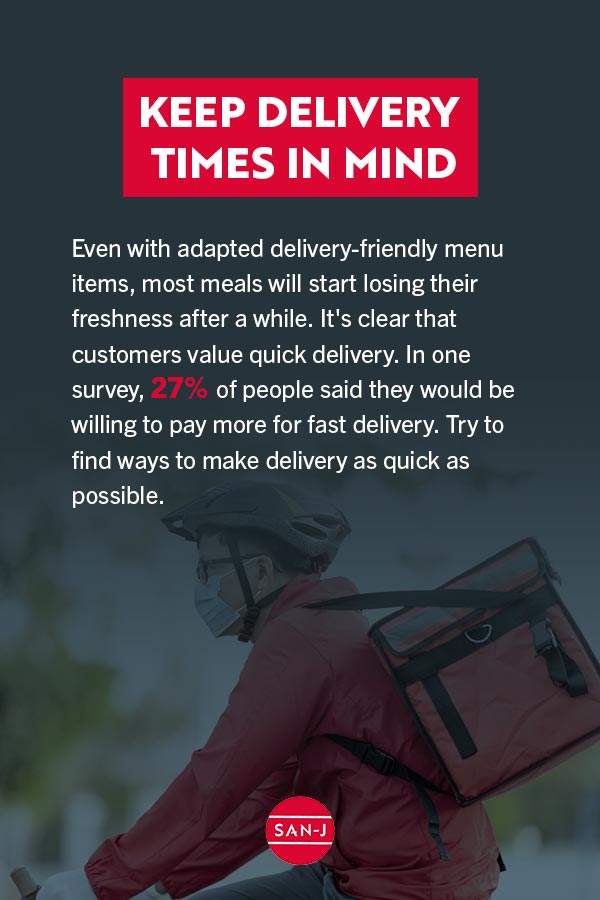
4. Keep Delivery Times in Mind
Even with adapted delivery-friendly menu items, most meals will start losing their freshness after a while. It’s clear that customers value quick delivery. In one survey, 27% of people said they would be willing to pay more for fast delivery. Try to find ways to make delivery as quick as possible:
- Preparation: Simpler, easy-to-make foods are usually best for delivery. Quick preparation ensures you can make the meals in a short amount of time and send them out to the customer. Your customer might not have the best experience if the meal they ordered takes 45 minutes to prepare. Keep prep times short to ensure a quick delivery.
- Total cook time: Foods like steak continue to cook even after they’re packaged. Be sure to factor this in for your total cook time. For example, you might be able to take a steak off the grill a little sooner so it’s perfect when it reaches the customer instead of overdone.
- Delivery area: You’ll want to make your delivery area fairly close to your restaurant. A long travel time could harm the customer experience. You may want to choose a radius and deliver within that circle, or you could select your delivery area based on average travel times. Be sure your delivery area will be favorable to your business and your customers.
- Drivers: Third-party delivery services can be an excellent option for your restaurant, as it ensures you’ll always have someone for delivery. If you use an in-house team, you may need to hire more people to ensure you always have someone on standby to deliver the next order.
Good delivery times will make your customers happy and earn your restaurant positive reviews for your services.
5. Make Sure the Food Is Presentable
Keeping food presentable even after it’s been delivered can be challenging. The route from your restaurant to the customer can cause food to shift around and become jumbled. Using the proper packaging and separating ingredients and sauces will help keep meals organized and appetizing. Try to label the different sauces and parts of the meal so customers know what’s what.
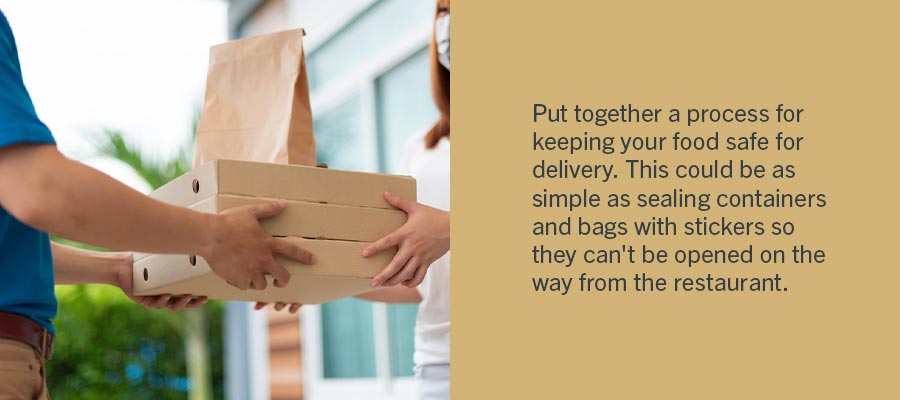
6. Be Transparent About Your Food Safety Measures
Customers often want to know that you take the proper precautions when it comes to food safety. Although the journey from your restaurant to the customer’s door may be short, they still want reassurance that no one tampered with their meal. Put together a process for keeping your food safe for delivery. This could be as simple as sealing containers and bags with stickers so they can’t be opened on the way from the restaurant. You could train your in-house team on the specifics of food safety or require drivers to wear masks or even gloves during delivery.
However you provide food safety, be sure to outline this process so customers feel more at ease. Cleanliness and food safety can even be one of your selling points. Use this to your advantage and display your safety process on your website.
7. Offer Options for Dietary Restrictions
Your delivery menu is likely going to be slimmer than your normal menu. Still, you should cater to all your customers and provide options for various dietary restrictions. Have a few items for vegetarians and customers who need nut-free or gluten-free options, and clearly mark these meals. Including items for particular diets will broaden your menu and prevent you from losing certain customers. Offering dishes to people with dietary restrictions is a sign of modernization. Today, people often expect these types of alternatives, so providing them can attract customers.
8. Allow Menu Personalization
Figuring out how to optimize your menu for delivery can be challenging. You want to keep the basic feel of your restaurant, but you may need to change dishes so they are suited for delivery. One way to balance these often competing goals is to allow menu personalization and let customers customize certain aspects of their meals. Since they won’t be sitting in the restaurant, customers won’t be able to communicate to a server about exactly what they want to eat. Provide personalization as an alternative.
Suppose a customer orders a burger. In that case, you can let them add or remove toppings, pick how they want their burger cooked and choose sides. Be sure to lay out personalization clearly so customers can easily see the various choices they have to customize their meals. Allowing customers to make small tweaks to their meals provides convenience for ordering and control over what they eat.
9. Put Your Menu Online
Converting your menu to your delivery is just one step in the process. You also have to make sure your customers can access your menu easily. The best way to make your menu reachable is to put it on your restaurant’s website. Your website is likely one of the first places someone will go when they want to order food for delivery, so you’ll want to ensure your menu is easy to find. Putting your menu online can have multiple benefits:
- Clarity: Explaining what your restaurant offers over the phone can be time-consuming and often ineffective. Instead, you can provide a full menu online that the customers can view at their leisure. You may also be able to add more information to an online menu. Dropdowns and bullet points give customers easy access to look at sides, customizations they can make to their meals, and crisp descriptions and images of each meal.
- Convenience: One of the best parts about an online menu is its convenience. Customers can determine what they want and maybe even order online, providing convenience to both the customer and the restaurant.
- Positive reviews: Additionally, you can also provide positive testimonials from customers beside your menu or even alongside certain dishes. These firsthand accounts of how good the food and delivery process were can help convert more customers.
10. Make Your Menu Mobile-Friendly
Ensure your menu and website are mobile-friendly to make ordering from your restaurant as simple as possible for the customer. Many customers will access your menu from their phones, so it’s worth spending some resources to make your delivery menu function just as well on mobile devices as on laptops.
11. Write Strong Descriptions
Make sure to craft clear, compelling descriptions that outline each meal option in detail. The better you can describe a particular dish, the better the customer will know what they’re getting and the more enticing it will be to order. Avoid going overboard with flowery language, but do include the main ingredients and the most significant flavors. You’ll also want to include any customizations your customers can make and whether the dish meets any special dietary requirements.
12. Incorporate Good Imagery Into Your Menu
Including high-quality imagery is just as important as including strong descriptions. Provide relevant pictures of all the meals you offer on the delivery menu. Many people like to see what a dish looks like before they order it. Providing quality imagery can give customers confidence about exactly what they’ll get.
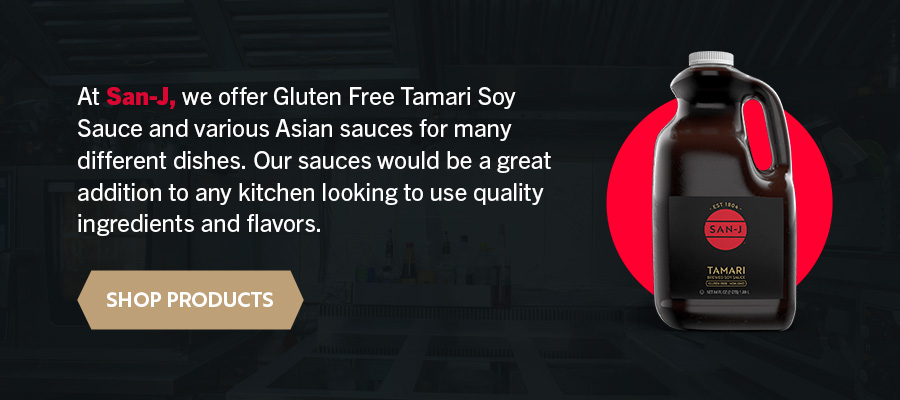
Add Delivery to Your Restaurant With These Tips
With the right information at your disposal, you can successfully adapt your menu for delivery. Using the correct packaging, emphasizing food safety, allowing for menu personalization and making your menu mobile-friendly will help customers during the delivery process. Once you have delivery services up and running, you can attract a new crowd of customers ordering from the convenience of their own homes.
At SAN-J, we offer Gluten Free Tamari Soy Sauce and various Gluten Free Asian Cooking Sauces for many different dishes. We’ve learned what it takes to craft a great sauce through eight generations of production. Our sauces would be a great addition to any kitchen looking to use quality ingredients and flavors. Browse our products online, and reach out today for your own sauces!
Back to Top

